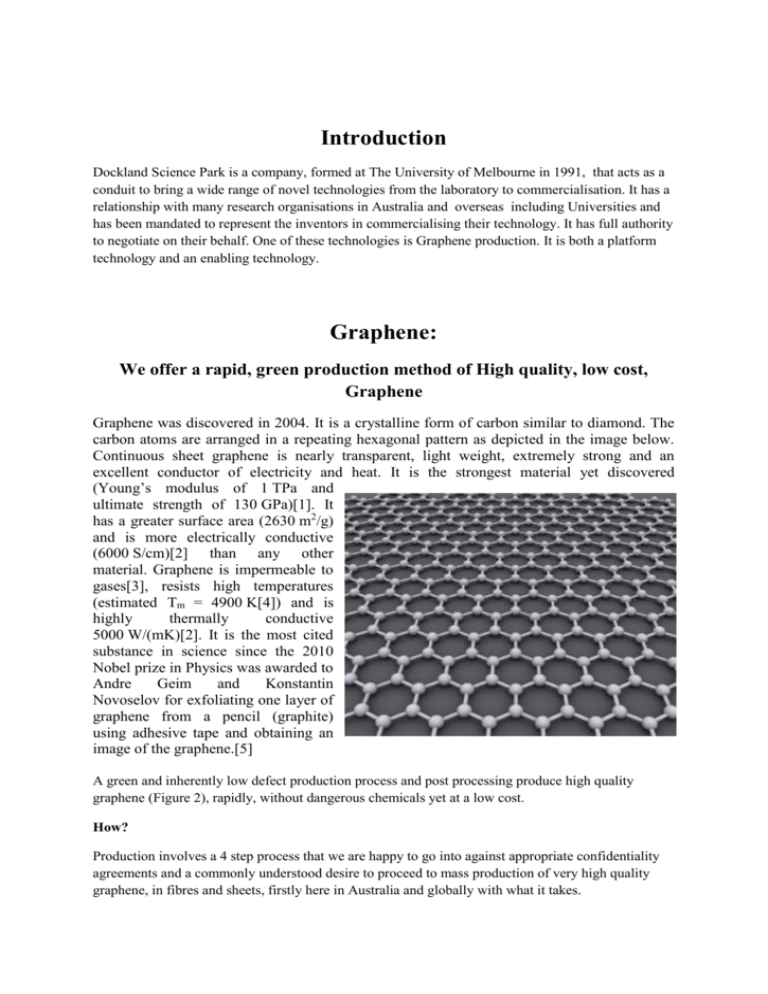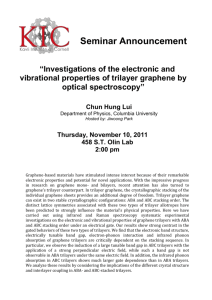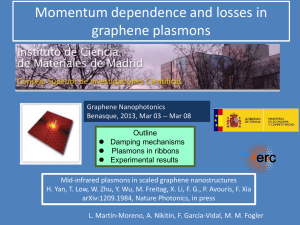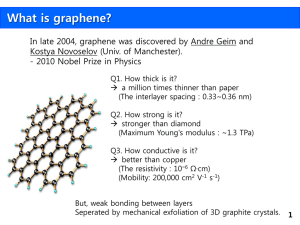Submission 11 - Attachment A - Docklands Science Park Pty Ltd
advertisement

Introduction Dockland Science Park is a company, formed at The University of Melbourne in 1991, that acts as a conduit to bring a wide range of novel technologies from the laboratory to commercialisation. It has a relationship with many research organisations in Australia and overseas including Universities and has been mandated to represent the inventors in commercialising their technology. It has full authority to negotiate on their behalf. One of these technologies is Graphene production. It is both a platform technology and an enabling technology. Graphene: We offer a rapid, green production method of High quality, low cost, Graphene Graphene was discovered in 2004. It is a crystalline form of carbon similar to diamond. The carbon atoms are arranged in a repeating hexagonal pattern as depicted in the image below. Continuous sheet graphene is nearly transparent, light weight, extremely strong and an excellent conductor of electricity and heat. It is the strongest material yet discovered (Young’s modulus of 1 TPa and ultimate strength of 130 GPa)[1]. It has a greater surface area (2630 m2/g) and is more electrically conductive (6000 S/cm)[2] than any other material. Graphene is impermeable to gases[3], resists high temperatures (estimated Tm = 4900 K[4]) and is highly thermally conductive 5000 W/(mK)[2]. It is the most cited substance in science since the 2010 Nobel prize in Physics was awarded to Andre Geim and Konstantin Novoselov for exfoliating one layer of graphene from a pencil (graphite) using adhesive tape and obtaining an image of the graphene.[5] A green and inherently low defect production process and post processing produce high quality graphene (Figure 2), rapidly, without dangerous chemicals yet at a low cost. How? Production involves a 4 step process that we are happy to go into against appropriate confidentiality agreements and a commonly understood desire to proceed to mass production of very high quality graphene, in fibres and sheets, firstly here in Australia and globally with what it takes. Our method is different from the normal chemical oxidation method which is used to separate graphene flakes. The commonly used chemical oxidation method damages the graphene (often 40% of the surface contains defects). Single layer graphene is very desirable. High quality graphene can be prepared by removing functional groups and repairing the matrix of graphene. This was tested by comparing the Raman spectra of the highest quality research graphene that could be purchased with our graphene. Our graphene had a higher 2D peak and lower D (defect) peak: D/G ratio was lower. Cost? Sigma Aldrich research grade graphene is around $500/g the best price obtained was around $1000/Kg from Cheap Tubes HDplas (cost price?). The production cost of our graphene will be around $50-$100/kg. Relevance? This graphene was originally designed with the intention of improving researcher access to graphene for experimentation. A cheap source of graphene will increase research and this will increase the number of applications. Strengths This process comes with a method of producing graphene and dispersing it: Dispersion is often cited as the second major production obstacle to commercialisation of graphene. Opportunities Graphene improves the properties of polymers at concentrations as low as 0.01 % (or less) so it doesn’t take much graphene to make a difference. Initially items like seals can achieve improved lifespan, helmets can be lighter and stronger, aircraft composite cracking can be eliminated, flexibility of polymers can be improved (pipes), the use of polymers in the automotive industry can be expanded and graphenes can be incorporated into the next generation of 3D printers e.g. It has been estimated that Carbon fibre would be 10x stronger if it used graphene. Likewise Kevlar is predicted to be particularly well suited to benefit from the use of graphene. Electronics Samsung has re-engineered the transistor to use graphene. If a cheap source of flake graphene was available companies will re-engineer components to take advantage of flake graphene instead of only using the less friendly CVD method. Graphene capacitors become more attractive to commercialise? Graphene is easy to work with… making it quick to commercialise. Research Research has been carried out on many aspects of graphene production without identifying a simple method to make lots of graphene rapidly and cheaply. Which is what this method achieves. Market? $9 M 2012 Lux research [7] $67 M 2015 BCC research [8] $100 M 2018 $675 M 2020 PR newswire [9] The value of graphene is really in the products it goes into. The value of graphene products in 2018 is estimated to be $1 billion [10]. However the reality is that once cheap graphene is available the market will be far larger. Conclusion Graphene created by our methodology is a green, simple and low cost method of making high quality graphene. The production method is scalable and can produce the tons of graphene industry wants. Low cost graphene will drive further research (which will increase applications) and will permit the use of graphene in large composite structures such as aircraft, infrastructure and large scale engineering projects while solving many of the problems of fatigue that these composites currently face. Figure 1 Both bulk materials and advanced polymer composites stand to gain from the use of graphene a) Storm water pipe b) Ligetti Stratos ultralight 3000 Relative Intensity 2500 G 2D Graphene X D HDPlas 2000 1500 1000 500 0 2700 2200 1700 Raman Shift 1200 (cm-1) 700 200 0.8 0.67 0.7 D/G ratio 0.6 0.5 0.41 0.4 0.3 0.2 0.1 0 Graphene X CT >700 m2/g Graphene type a) Raman spectra listed at the G peak from highest to lowest 1) Graphene (Highest 2D peak!) 2) HDPlas b) D/G ratios Figure 2 NB. Graphene X has the highest 2D peak and has the lowest D/G ratio! Results from commercial high quality graphene are included to allow comparison (refer unpublished articles for more information). References 1. 2. 3. 4. 5. 6. 7. 8. 9. 10. Beech, R., Nanoscale Graphene Platelets taking its place as an emerging class of nanomaterials. Nanotechnology Law and Business, 2011. Spring. Kim, H., A.A. Abdala, and C.W. Macosko, Graphene/Polymer Nanocomposites. Macromolecules, 2010. 43(16): p. 6515-6530. Kim, H., Y. Miura, and C.W. Macosko, Graphene/Polyurethane Nanocomposites for Improved Gas Barrier and Electrical Conductivity. Chemistry of Materials, 2010. 22(11): p. 3441-3450. Zakharchenko, K.V., et al., Melting of graphene: from two to one dimension. Journal of Physics: Condensed Matter, 2011. 23(20): p. 202202. Nobel Foundation. Nobel Prize in Physics 2010. 2010 [cited 2011 27/5/11]; Available from: http://nobelprize.org/nobel_prizes/physics/laureates/2010/press.html. Narayanan, B., et al., Carbon monoxide-induced reduction and healing of graphene oxide. Journal of Vacuum Science & Technology A: Vacuum, Surfaces, and Films, 2013. 31(4): p. 040601-8. Carole, J. Graphene Market Set for 40% Annual Growth, Reaching $126 Million in 2020. 2013 [cited 2013 15/7/13]; Available from: http://www.luxresearchinc.com/news-andevents/press-releases/147.html. Graphene: Technologies, Applications, and Markets. 2011 [cited 2013 15/7/13]; Available from: http://www.bccresearch.com/market-research/advanced-materials/grapheneapplications-markets-avm075a.html. Reportlinker Adds Graphene: Technologies, Applications, and Markets. 2011 [cited 2013 15/7/13]; Available from: Reportlinker Adds Graphene: Technologies, Applications, and Markets. Markets, R.a. Research and Markets: The Graphene Opportunity Report. 2013 Edition Takes a Rational View of Graphene and Identifies Key Opportunities 2013 [cited 2013 27/8/13]; Available from: http://finance.yahoo.com/news/research-markets-graphene-opportunityreport-172900479.html.






